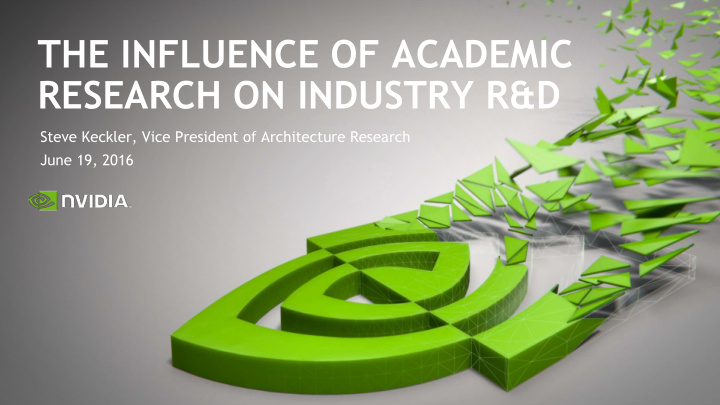



THE INFLUENCE OF ACADEMIC RESEARCH ON INDUSTRY R&D Steve Keckler, Vice President of Architecture Research June 19, 2016
Academic/Industry Partnership AGENDA Architecture 2030 2 @NVIDIA 2016
My Background/Experience 14 years as tenure-track professor at UT-Austin 6 years leading architecture research at NVIDIA Drive architecture research beyond product time horizon (5-10 years) Pay attention to trends and academic research Not just architecture but applications, technology, programming systems, etc. Collaborate with university researchers (and other companies) Invest heavily in technology transfer with product teams 3 @NVIDIA 2016
Disclaimer These are my opinions. They represent my experiences. My observations may not necessarily be consistent with experiences at other organizations. 4 @NVIDIA 2016
Current NVIDIA/Academic Collaborations That I know of 5 @NVIDIA 2016
Examples of Technology Transfer At NVIDIA Streaming architectures (Merrimac, etc.) Brook/Cuda CuBLAS CuDNN Machine learning frameworks (Caffe, Torch, Theano, etc.) A lot more in the pipe... 6 @NVIDIA 2016
Observation 1: Technology Transfer Gap Industry Product Team Research Acceptance 7 @NVIDIA 2016
Observation 1: Technology Transfer Gap Academic Product Team Papers Acceptance 8 @NVIDIA 2016
Observation #2: Academic Papers Yes – we do read LOTS of them It’s a Trap: Emperor Palpatine’s Poison Pill Plus guest lectures, intern talks, Zachary Feinstein 1 Washington University in St. Louis etc. December 1, 2015 arXiv:1511.09054v1 [q-fin.GN] 29 Nov 2015 Wide audience: research + Abstract product teams In this paper we study the financial repercussions of the destruction of two fully armed and operational moon-sized battle stations (“Death Stars”) in a 4-year period and the dissolution of No institutional ignorance of the galactic government in Star Wars . The emphasis of this work is to calibrate and simulate a model of the banking and financial systems within the galaxy. Along these lines, we measure good research the level of systemic risk that may have been generated by the death of Emperor Palpatine and the destruction of the second Death Star. We conclude by finding the economic resources the Rebel Alliance would need to have in reserve in order to prevent a financial crisis from gripping the galaxy through an optimally allocated banking bailout. 2 Key words: Star Wars ; systemic risk; financial crisis; financial contagion; bailout allocation 9 @NVIDIA 2016
Observation #3: Value of an Individual Idea A Product Consists of Thousands of Ideas/Inventions Reasonable to explore an idea in “isolation” But acceptance depends on interaction between the idea and all of the other factors in the design 10 @NVIDIA 2016
Observation #4: Experimental Results We don’t believe your simulator But don’t despair – the product teams don’t believe ours either More important than precise results include Quality of the idea Characterization of opportunity Insight into range of solutions Good ideas will get re-examined in context of product roadmap 11 @NVIDIA 2016
Observation #5: Field Can Advance Quickly Product Can Be Ahead of Academic Research Can point to papers that have been superseded by product features at time of publication Incremental research in well- trodden area is not usually relevant 12 @NVIDIA 2016
How to Minimize the Impact of Your Research Work on well-trodden and near- Don’t visit or take sabbatical term areas time in industry More warp scheduling papers Focus your papers/presentations please on the results at the expense of Optimize research for ideas and characterizations maximizing paper count Expect that your ideas are so Don’t develop direct good that they will be adopted relationships with industry all by themselves research and product teams 13 @NVIDIA 2016
Architecture 2030 14 @NVIDIA 2016
2002 2016 2030 ? Pentium4 GP100 GPU 130nm 5.5M xtors 1 core 4-way HT 16nm ~6 GF 15.3B xtors (300x) ~2K math units (1000x) ~5.3TF (~1000x) 15 @NVIDIA 2016
Emerging (Esoteric) Technologies Quantum Molecular DNA 16 @NVIDIA 2016
Cost Manufacturability Programmability Reliability Predictability 17 @NVIDIA 2016
Innovator’s Dilemma Christensen, 1997 Inferior disruptive technology can eventually displace incumbent if it can leverage high growth sector of market. So-called esoteric technologies need high-volume “killer app”. 18 @NVIDIA 2016
“I would predict that in 10 years there’s nothing but quantum machine learning—you don’t do the conventional way anymore.” - Hartmut Neven (Google); MIT Technology Review 6/9/16 Is this plausible? 19 @NVIDIA 2016
The Death of “New” Chips? Slowing of Technology Opens up Architecture Competitive Landscape 20 @NVIDIA 2016
2030 Predictions No wholesale replacement of CMOS (and its direct derivatives) Ample room for innovation in packaging, circuits, heterogeneous systems (electrical, optical)...and Software 21 @NVIDIA 2016
2030 Predictions No wholesale replacement of CMOS The system will be more important than the chip 22 @NVIDIA 2016
2030 Predictions No wholesale replacement of CMOS The system will be more important than the chip Ample room for domain-specific acceleration 23 @NVIDIA 2016
2030 Predictions No wholesale replacement of CMOS The system will be more important than the chip Ample room for domain-specific acceleration We will still be struggling with programmability Parallel and Programmability Heterogeneous vs. Fixed-Function Systems 24 @NVIDIA 2016
2030 Predictions No wholesale replacement of CMOS The system will be more important than the chip Ample room for domain-specific acceleration We will still be struggling with programmability Chip design will be even more like SW design Catapult HLS PyMTL Stratus HLS 25 @NVIDIA 2016
Summary “Rennaissance” for architecture research Architecture will continue to increase in importance But needs to span stack (circuits to applications) Stay the course on architecture principles Data transformation, date movement, data storage Parallelism, locality, etc. Key opportunities Scalability – at multiple levels Domain-specific acceleration 26 @NVIDIA 2016
Recommend
More recommend